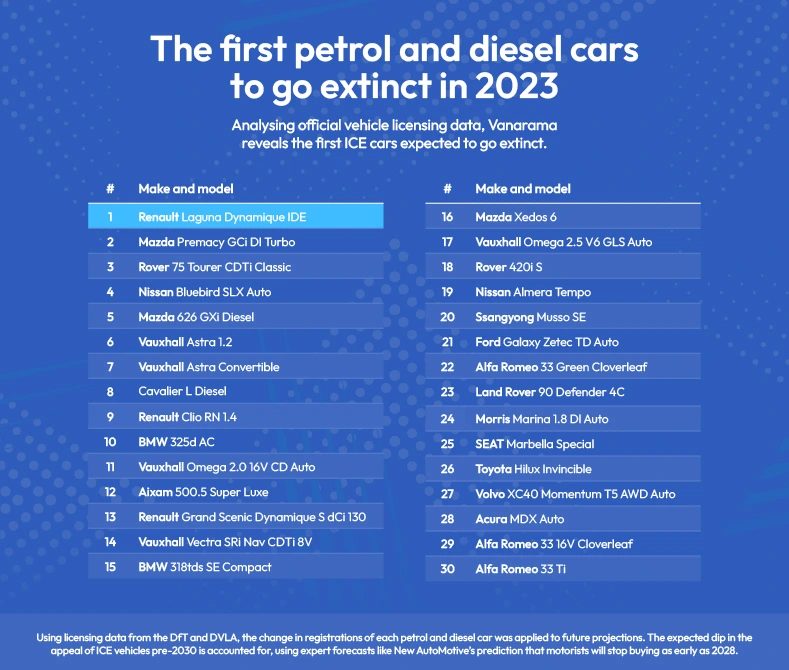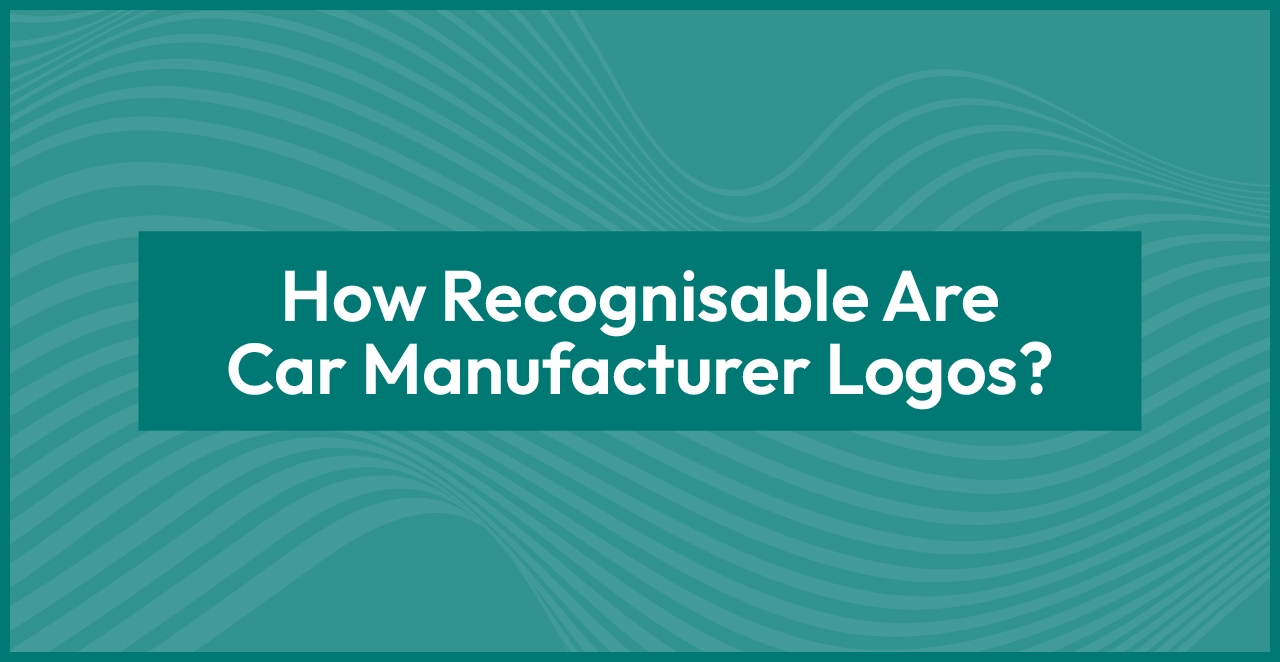It’s no surprise that the UK, and indeed much of the world, is moving towards electric motoring. What isn’t so clear, however, is when we’ll be ready for the majority of drivers to make the switch.
Based on the latest UK vehicle licensing data from the Department for Transport and Driver and Vehicle Licensing Agency, we predict when internal combustion engine (ICE) cars will be no more – as well as which of them will be the first and last to go.
Key Findings:
- ICE cars are expected to last another 105 years, despite the ban on new petrol and diesel sales being only seven years away
- The Ford Fiesta Zetec is expected to be the last standing
- 122 petrol and diesel models will go extinct this year (2023), with the Renault Laguna Dynamique IDE going first
- By the end of 2023, a total of 122 ICE cars will go extinct
Despite The 2030 Ban On New Petrol And Diesel Cars, Existing Models Are Expected To Last Another 105 Years
Within seven years, UK motorists will no longer be able to buy new cars powered solely by petrol or diesel. Five years from that, in 2035, hybrids will meet the same fate.
But, going by our analysis of car registrations data, it’ll be a century before we’re ready to give up ICE cars for good – 105 years to be exact. That’s because the switch to electric can’t happen overnight. In fact, we estimate that the number of ICE cars will actually increase before it begins dropping.
Brand-new petrol and diesels can be bought up until 2030, and we predict there’ll be a total of 30.4 million by 2027. That’s a rise of nearly three quarters of a million (717,011) on the current figure, based on all 42,242 petrol and diesel cars licensed right now and how quickly they’re increasing or decreasing in number since 2021.
Within A Decade Of The Ban, The Number Of Remaining ICE Cars Could Be Its Lowest Since The ‘70s
Beyond 2027, and despite current plans permitting used sales post-2030, our projections show a quite dramatic drop. By only 2035, the total number of licensed petrol and diesel motors could drop by more than half to just 14.3 million. There hasn’t been that few since the 1970s.
To calculate this, we used forecasts from New AutoMotive to estimate how the number of ICE registrations could be impacted as we near 2030 and then applied an average rate of change (-13% per year) to all vehicles from 2031.
The only vehicles not subject to the average decrease are those already decreasing at a quicker rate – such as the Saab 9-3 SE Turbo Automatic at -16% per year – as the ICE car bans are unlikely to slow their decline.
Our projections are of course subject to several variables, such as the 2030 and 2035 bans being altered or the government announcing stronger incentives for going electric. These findings are an estimation based on current data and trends, which show there’s much more to be done if the UK is to be ready for a switch anytime soon.
The Ford Fiesta Zetec Will Be The Last-Ever ICE Car
The combustion-engined car expected to be the last standing is the Ford Fiesta Zetec. Many examples of the Zetec appear in our database, such as the Fiesta Zetec Turbo that also appears among the last to go extinct, but it’s the standard manual model that’s expected to go the distance.
With 372,807 of them still on the road, it’s hard to imagine the Fiesta Zetec ever hitting zero examples – especially when the fifth-placed MG ZS VTi-TECH Exclusive has only 8,738 currently.
However, that’s explained by the MG being a much newer model and one that’s still growing in number. We project there’ll be 100,541 ZS VTi-TECH Exclusives by 2027, before numbers halt for a few years and then start to fall. Between the Ford and MG are the MINI Cooper, Fiat 500 Lounge and Volkswagen Golf Life TSI, which are expected to go by 2121.
The First ICE Vehicles Will Vanish Within Months
Our data also tells us which petrols and diesels will be the first to go, and it’ll be this year. The Renault Laguna Dynamique IDE tops the list, but by the end of 2023, a total of 122 ICE cars will bow out – we’ve ranked which 30 will do so the soonest.
Among them are six Vauxhalls, including the Astra 1.2 and Cavalier L Diesel, three Renaults and even two BMWs – both of which being earlier 3 Series models (the 325d AC and 318tds SE Compact). In fact, BMW is the only premium German brand to feature at this end of the results.
Browse the latest Vanarama car lease deals if you’re considering an upgrade, or find more automotive news and insight on our blog.
Methodology
We started by pulling the latest Department for Transport and Driver and Vehicle Licensing Agency data on all licensed vehicles in the UK, sifting out all models that weren't tagged as a car with either petrol or diesel as its only fuel source.
Specific models and trims are included, rather than using top-level averages, to avoid swaying the data. For example, newer editions of long-standing models like the BMW 3 Series are still be increasing in number while older editions are on the decline.
A percentage change in the figures since 2021 was calculated to determine which models are currently increasing and decreasing in number. The yearly change was applied to each model to predict figures over the coming years, before sales are expected to dip ahead of the ban on new petrol and diesel car sales. To account for this, we applied a rate of change that reflects forecasts from New AutoMotive, who believe ICE sales will stop from 2028.
Beyond 2030, we applied the average yearly change of all models currently decreasing in number (-12.836909%) to all vehicles, to account for the impact the bans will have on ICE car registrations. The only exception to this average was cars that are already decreasing in number at a quicker rate than the above average, as the bans are unlikely to slow this decline.
Other exceptions included models that had huge percentage increases, such as models that are released at the end of one year before production and orders ramp up the following year. We also applied an average increase to these vehicles, to avoid applying short-term spikes in registrations to our future projections.
This data is subject to several variables, such as the 2030 and 2035 bans being altered or stronger incentives being announced for switching to an electric car. These findings are an estimation based on current data and trends.







